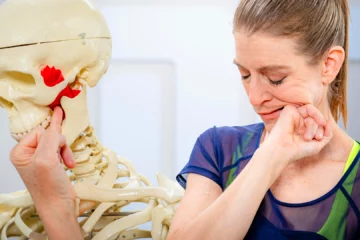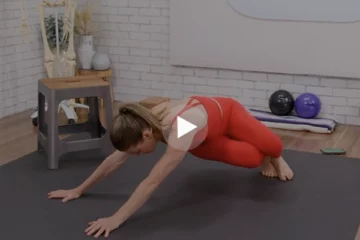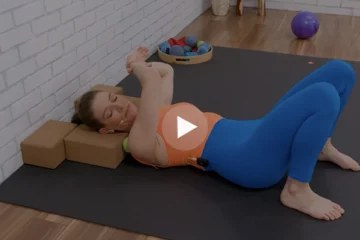
Why make a passively shortened muscle shorter by actively contracting it?
I’m so glad you asked. First of all, how much a muscle contracts is a major determinant of its size and rate of cellular regeneration. Decrease muscle activity and the rate of protein degradation will accelerate, resulting in muscle atrophy. Increase muscle activity and boost the production of new proteins.
Second, you never want to stretch a muscle when it’s cold. Concentric muscle contractions before static stretching minimize stretch-induced force deficits. In plain-speak, marching in place prior to stretching prevents the muscle from weakening after a static stretch.[1]
Lastly, to keep a muscle healthy, its nerve must supply both impulses (contraction instructions) and certain chemical factors. A muscle that is deprived of electrical or nervous stimulation will degenerate. On the other hand, an active muscle can increase short-term blood supply by telling its capillaries to open and implement longer term changes by causing the proliferation of capillaries.[2] This is why muscles also need to warm up prior to an extensive workout, and particularly before “cardiovascular” work. If the heart rate goes from resting to aerobic, the heart pumps a much larger quantity of blood – that needs to go somewhere. If the capillaries in the muscles are not open to receive the additional blood flow, it’s like turning on a fire hose that’s connected to a cocktail straw. This is not kind to blood vessels. And guess what happens to blood pressure if the muscles are cold and heart rate goes up?
If you’ve been guilty of inflicting long passive stretches or hundred-yard dashes on cold muscles, relax. Muscles can heal themselves and grow stronger with a sensible and healthy practice like Yoga Tune Up. Active muscles that are kept at their optimal lengths move more blood, oxygen and nutrients – and increase one’s basal metabolic rate. Better cellular regeneration and burn more calories while you sleep. The body is pretty spectacular.
May all beings be healthy,
Alexa
P.S. For all you fitness nerds: I urge you to walk optimally to grab a copy of Prime Mover by Steven Vogel. It’s a fascinating and entertaining introduction to the muscle in the context of biomechanics.
Learn more about our YogaTune Up Teacher Training.
Be sure to check out our videos on YouTube.
[1] Whaaaaaaat?!?! Stretching weakens muscles? Yes, under certain conditions. Static stretching of cold muscles has been shown to damage muscle fibers. Eccentric stretching under heavy load conditions has also been shown to damage muscle fibers. And overstretching the muscle-tendon complex can increase joint instability and increase the risk of injury. Anthony D. Kay & Anthony J. Blazevich, Concentric Muscle Contractions Before Static Stretching Minimize, But Do Not Remove, Stretch-Induced Force Deficits, Journal of Applied Physiology, 108: 637–645 (2010).
[2] Steven Vogel, Prime Mover, A Natural History of Muscle (2001)












Good analogy of what happens when you do cardio without warming up! I will keep this in mind as I move forward in my rebuilding journey. So many muscles, so many tissues to love and care for!
Awesome! Again, thank you for sharing and explaining the how and why with humor and simplicity. I enjoyed your analogy, “If the capillaries in the muscles are not open to receive the additional blood flow, it’s like turning on a fire hose that’s connected to a cocktail straw.”
I also appreciate your light hearted and positive message at the end, as well, your book recommendation for “fitness nerds”. : )
thank you, I always wonder why I had to cool down after running
Thanks for this article. I am taking Level 1 YTU with Todd and he has been speaking of the need to warm up. He said he likes to take an hour warm up if he can before dead lifting. We all need to make sure e are giving our uses what they need before we put demands on them. With YTU, I now have science behind how to do this effectively.
I appreciate how you explained the details of why we should warm up our muscles first. So often we hear that it should be done, but no one really goes into the “why”.
So basically we all should be doing marching minivini … every day.
I learned a lot reading Part 1 and 2 and am encouraged to learn the body is such a wonderful machine. It is amazing that we can abuse our body for years, yet it will turn the corner and start to heal when our habits become more positive. As a student of Yoga Tune Up I am learning to be kinder to my body, the results you wrote of are inspiring me to keep trying.
My passively shortened hamis thank you! As my legs have gotten stronger I’ve been getting really tight hamstrings without good ways to stretch them out – I was a dancer for years and because of that I think I have over-loosened tendons. I’m realizing now because of your article that my calves and hams are probably tight though because I’m constantly indulging my gangly architecture! I’m a knee bender, crossed-legged seat-er, curl-up-to-watch-tv-er. Good to know a possible solution to my tightness is simple – just change the way I’ve been sitting and walking and studying and relaxing for my whole life! 😉
What a terrifically explained article (part 1 and 2). I appreciate your use of muscle physiology terminology. I have done a fair bit of peer review journal reading of physiology and biomechanics in my graduate work but I had not yet come across the article you cited concerning the use of dynamic stretching before static reduces force deficits. Yet one more reason to encourage my students to move it before the stretch it! Also, thank you for the reading recommendation. I will add it to the reading list.
If the heart rate goes from resting to aerobic, the heart pumps a much larger quantity of blood – that needs to go somewhere. If the capillaries in the muscles are not open to receive the additional blood flow, it’s like turning on a fire hose that’s connected to a cocktail straw. This is not kind to blood vessels. And guess what happens to blood pressure if the muscles are cold and heart rate goes up?
Like that, and I have had that feeling before you almost can feel sick. I wonder also if that is the reason you hear fit people dropping dead as they were going out for a run. Did they just go straight to aerobic and it pumped to much quantity of blood?
Interesting..
Alexa, Thank you for the additional knowledge in this area. I also find it so important to do some sort of warm up prior to taking students into the deep stretches that are often asked in a yoga class or stretching program. I work with a lot of athletes and thus find that we do a lot of dynamic stretches before any sort of game/ movement that is required of them. It’s only after their main workouts / games that we really go for the deep work. Your blog posts summarize the importance of these decisions perfectly! I, too, look forward to walking optimally to pick up Prime Mover. It sounds like an excellent resource for additional knowledge. Thank you for sharing. [As a side note, I wish I had read the post above about the working from heels to flats in stages when I left the fashion industry. That was a tough transition for me — 4-5″ daily heels to bare foot. Ouch.]
Wow! Such an informative pair of articles!
Thanks so very much for the juicy references! I am going to the library just as soon as I unfold my shortened psoas-es and remove myself from this computer!
Here I go: harrrummmmphrrrr. I am up now. Looking for my keys, so I can sit in the car to get to the library to sit and read…
Ah me. I am a student of my own psoas.
Hi Monica,
An analogy that comes to mind is a door stuck midway between open (relaxed) and closed (contracted) because it’s been left in that position too long. A person may want to open the door to it’s maximum, but the hinges have rust in the way. So closing it fully first might be easier and shake some of the rust off. The other analogy is jump starting a car engine. But neither is quite right. Luckily, there are researchers who don’t need analogies, such as the ones who did this study: “Effect of submaximal contraction intensity in contract-relax proprioceptive neuromuscular facilitation stretching,” Br J Sports Med 2004;38:e18 doi:10.1136/bjsm.2003.010967: “To determine if submaximal contractions used in contract-relax proprioceptive neuromuscular facilitation (CRPNF) stretching of the hamstrings yield comparable gains in hamstring flexibility to maximal voluntary isometric contractions (MVICs) …significant change in flexibility [was found] for all treatment groups … all treatment groups had significantly greater flexibility than the control group.” Thanks for your comment – and yes, there is so much to process!
wow – great article. I always thought you first needed to release a tight muscle in order to strengthen it…… I am still processing all of this 🙂
Great set of articles, Alexa! It’s so important to differentiate strong vs weak from tight/short and lax/long. Healthy muscles, as you explain well, are both supple and strong. And supple strength requires movement in all available ranges of motion.
Thank you for listing your source for the statement, “Concentric muscle contractions before static stretching minimize stretch-induced force deficits.” I come from the camp that greatly minimizes deep static stretching in the warmup – especially when going into a HIIT style workout. Thanks for sharing.
I really like the part regarding tight muscles from over use vs. tight from passive contraction …..I have a better understanding…and this is helpful to pass on to students who sit all day at a desk. We need to get up and move if we are desk sitters!
i appreciate how you broke down in simple terms the effect of not loosening and paying attention to our muscles can have on our bodiies. It reminded me to pay attention prior, duriing and after my practice to prevent injury
I loved this article, because it really clearly answered one of the big contradictions that bugged me from my own first teacher training when they said “if you overstretch your tight lower back it will become weak”…that always seemed counterintuitive to me. I also think it is amazing how smart and adaptive the body is. Culturally, we have this weird misconception that we know better than our bodies and that technology and fancy machines will help us make ourselves better. But the truth is our bodies know exactly what is up and are just trying to keep pace with all the ridiculous stuff we are doing to them.
[…] Tune Up® Blog « Abdominal Massage: What Do You Store In Your Core? What You Don’t Contract Can Kill You, Part 2 […]
I am thinking about this with regard to a yin practice. It is intended to be practiced with cool muscles to allow the stress to be taken in the ligament/joint capsule, as I understand it. However, the poses are still long passive static stretches on the muscle, so the practice over time (without including a warm up) could result in damaged muscle fibers? Most yin classes I attend include no or very minimal dynamic stretching, and although I always felt I should do some warm-up I generally do not. Rethinking this for sure.
Hi Simone,
Thank you for your question. Because each person is at least a little (or a lot) different from the next person, the best person to answer whether you are warmed up enough is – you. And you will be different each and every day, hour, yoga practice, from the one before, depending upon what your body has been doing. If you’ve been sitting all day in the office or car, you will probably need more time to warm up/reactivate the muscles all over your body than if you had been moving regularly throughout the day. One barometer that’s nice to use is your breath. Is the breath easy and even as you move through a yoga pose? Is it panicked breathing? – which may be an indication that one or more muscles are not ready to reach a certain length. Are you remembering to breath? Also, make sure to check in with yourself and how you breath throughout the day. Clavicular (upper chest and shoulders) breathing tends to cue the body to tense – even if you have nothing to be tense about, but many people default to breathing this way out of habit. Rib breathing (rib cage expands) is better when the body is upright and active (and not in panicked flight). If you go into a slow flow yoga class without any prior warm up, you can go even slower and use the movements to warm up. There’s absolutely no need to get to your end range with the first sun salutation. It can be the tenth or twentieth. Listen to your body and back off if anything resembles pain. As Jill Miller likes to say, “Be a student of your body.”
Thanks this is a helpful explanation. I am wondering if you could say more about how much warm up time is enough. For example, sometimes I would go straight into a slow flow yoga class. Does the opening routine of such a class offer sufficient warm up for the stretches that are done? Is there any way of gauging what is enough warm up?
P.S. One important caveat about going barefoot and to wearing totally flat shoes: If a person has literally spent years and most of his/her waking hours in high heels, that person may need to take his/her heels down in stages – e.g., 1 inch at a time. This is to prevent injuring calf muscles that may have become shortened due to elevated heels. The body changes over time (and with persistence), not overnight.
Hi KC,
I don’t like to prescribe specific post-workout stretches without knowing what you are doing during your workouts. However, it is important to let muscles that have done a lot of contraction to relax or stretch back to their optimal resting length. A muscle’s reason for existence is its ability to contract. However, it must also return to its optimal length in order preserve is optimal ability to contract. One way is to train the body (and mind) to release the contraction. Another is to actively stretch the muscle fiber. If the stretch is done properly and held long enough (but not too long), then receptors in, along and in the connective tissues around the muscle will provide signals for release. Also, it sounds like you are spending a lot of your workout time in high heels. If this is so, it is very important to treat your feet to regular massages, either by hand or with tools like the Yoga Tune Up Therapy Balls. (Remember to stretch the tops of your feet!) Also, spend as much time as possible barefoot, walking (in totally FLAT SHOES – if you must wear shoes outside) and activating each of your toes. And stretch your calves regularly. Keeping all parts of the feet limber, active and strong will help with your back and knees – and shoulders and hips – and spine – you get the drift.
All the best,
Alexa
Yes! thank you so much for such a detailed explanation of the anatomical and medical reasons behind stretching pre-workout, and that it’s not simply to stretch muscles so that they don’t bulk up too much and lose flexibility. I am a dancer primarily in musical theatre, which unfortunately means that I am often dancing around in 3 inch character heels. I developed a minor knee injury doing a show in period lace up narrow high-heeled boots. It was very aerobic dancing with lots of partner work and lifts that were so fast that i was often “dropped” down to the ground pretty quickly out of them. This started to wear on my lower back and knees. I started intense stretching and warm ups geared towards strengthening the shin and surrounding knee area by lots of plies and foot flexion exercises, paired with jumps. This helped immensely. I’ve also been told that post-workout stretching and a “cool down” is sometimes even more important. Is this true?
Such a good reminder to NOT neglect our muscles. I used to run a lot and barely gave thought to my warm up or cool down. I even trained for the full Nike Marathon years ago, and the trainers didn’t really go into how important it was to treat the muscles we were using right. Ironically enough, I “pulled” my patella and really screwed up my knee in the last training run. It was excruciating pain, and to this day still feel some sensitivity in that one knee, and of course don’t run anymore. Now i know it probably had a lot to do with how i neglected my muscles and failed to learn more about my body before throwing it into such a harsh situation like running 26 miles.
Thank you for this crucial information. I now understand in a more comprehensive way, why warming up is SO essential before a muscle stretch or work out. Also, I am interested in the book. I’m assuming it’s available through Amazon?
Hi Jen G,
Yes, you’ve got it!
Wow! This is a lot of detailed information. What I’m getting is that the bottom line is that if you don’t you it in a healthy way you loose it. Is that correct? It seems like you are not just advocating contracting the psoas more but a program of contraction/warming up the muscle and then stretching it out.
Awesome! “Concentric muscle contractions before static stretching minimize stretch-induced force deficits” Who would have thought! This is making me re-think how I teach my yin class… Big Time!
Thank you for clearing things up. Missed the whole warm up idea of the contraction. After reading part 2 it makes perfect sense.
Excellent! Part one and part two. You do a great job explaining this whole concept. As a young dance major in college I was running up campus or down campus to get to my next class(cold muscles) after sitting in a lecture hall for two hours. Hi shortened psoas muscle!!! Yes, I always had problems with my psoas. My body would be in complete shock. Or I was showing up to some, not all, of my rehearsals with out properly warming up and then going into some deep stretches because my body could( or at least I thought it could). That would explain why I was Sooooo flexible but I was weak and had no proprioception. Yay YTU to the rescue!! Thanks Alexa for the book suggestion too.